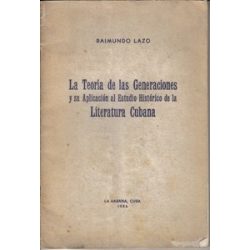4.1.3 The post-Origenist generation in Cuban poetry, from the late 1940s until 1959

Although the generational approach to the study of literature has often been questioned and lacks sufficient research support, the truth is that there are general traits that define poetic activity in certain periods of history, without attempting to pigeonhole the styles and worldviews of dissimilar individuals into a monolithic framework.
In this sense, the final Republican years, in addition to being imbued with Origenism, also brought the emergence of another group of creators who, without denying the discoveries of the group’s members and the magazine, deployed a poetic approach in which neo-romanticism prevailed and the contributions of the avant-garde were revived. Many members of this new generation wrote important works during this period, and others would truly rise to prominence after the triumph of the Revolution.
It was Raimundo Lazo, in his 1954 acceptance speech at the Cuban Academy of Language—later published under the title “Theory of Generations and its Application to the Historical Study of Cuban Literature”—who coined the term “post-origin generation” to refer to these new poets, all of them young people born well after the first quarter of the century.
The creators of this generation were greatly influenced by the poetry of Juan Ramón Jiménez, beginning with his visit to Havana in 1936, in addition to the aforementioned neo-romanticism that occasionally skewed higher endeavors. The oscillation between the intimate and the social was resolved for many of these writers in a poetry of deep commitment after the triumph of the Revolution, as was the case with Rolando Escardó, Roberto Fernández Retamar, and Fayad Jamís, to name just a few.
Other notable members, then pursuing a poetic apprenticeship that would become increasingly mobile in their lives, included Carilda Oliver Labra and Pablo Armando Fernández, as well as Rafaela Chacón Nardi, Pedro de Oraá, and José Álvarez Baragaño. However, there were also some practitioners who would move toward other spheres of artistic expression or simply abandon poetry altogether, such as Tomás Gutiérrez Alea and Mario Rodríguez Alemán, authors of “Reflejos” (Reflections) (1949) and “Suite” (1947), respectively. Ventura García, meanwhile, conceived the poetry collections “Vendimia de primavera” (Spring Harvest) and “La sonora inquietud” (The Sound of Restlessness) (The Sound of Restlessness) between 1947 and 1948.
This group also includes poets such as Raúl Gómez García and Frank País, who lost their lives in the heat of the revolutionary struggle and were therefore unable to leave behind extensive examples of their lyrical work. This was a generational group that gradually coalesced over time and with the opening of editorial spaces in magazines and newspapers of the time, such as the Diario de la Marina itself, with its “La promesa de los jóvenes” (The Promise of the Young), sponsored by Jorge Mañach and Gastón Baquero, as well as “Renuevo” and the associated “Movimiento juvenil literario” (Youth Literary Movement). However, the most important works were written outside of these endeavors.








